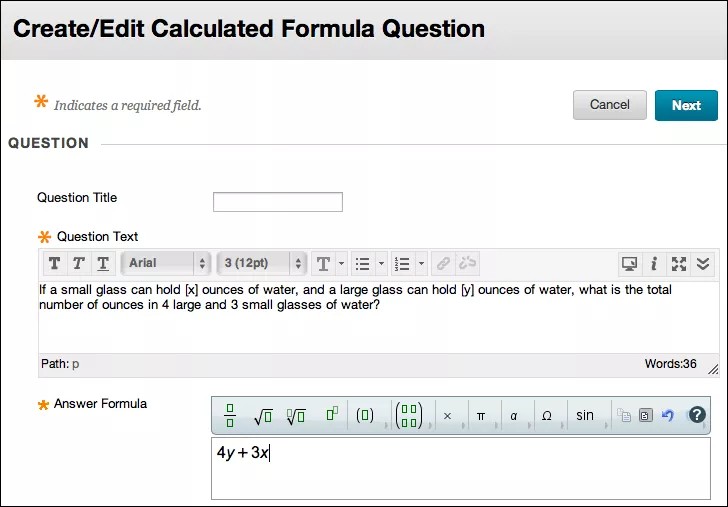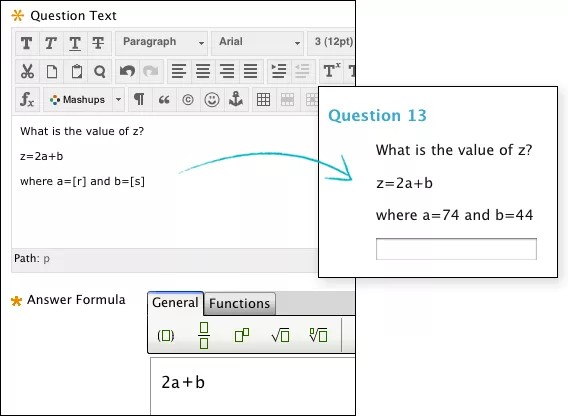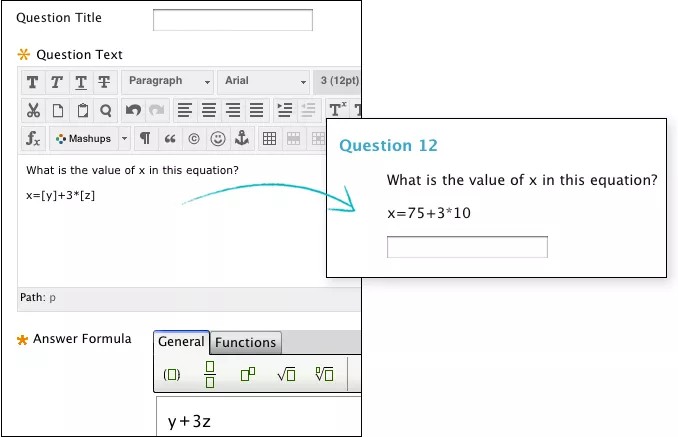Calculated Formula questions present students with a question that requires them to make a calculation and respond with a numeric answer. The numbers in the question change with each student and are pulled from a range that you set. The correct answer is a specific value or a range of values. You may grant partial credit for answers that fall within a range. Calculated Formula questions are graded automatically.
In the example, the numbers 6 and 9 are randomly generated from a range of values set by an instructor.
An instructor created this question:
If a small glass can hold [x] ounces of water, and a large glass can hold [y] ounces of water, what is the total number of ounces in 4 large and 3 small glasses of water?
When a student views the question, the variables [x] and [y] are replaced with values that are generated randomly from number ranges that the instructor specifies.
More on Calculated Formula questions with JAWS®
Create the question and formula
- Access a test, survey, or pool. From the Create Question menu, select Calculated Formula.
- The Question Text must contain at least one variable. Surround variables with square brackets. Variables are replaced by values when shown to students.
Variables must consist of letters, but "pi" and "e" are reserved, so you can't use them as variables. You can't reuse variable names. Variables can contain more than one character, such as [ab] or [cd].
All other occurrences of the opening rectangular bracket ("[") should be preceded by the backslash ("\").
You can also add files or media to the question text.
- The Answer Formula is the mathematical expression used to find the correct answer. Choose operators from the functions across the top of the Answer Formula box. In the example, the formula is 4y+3x.
The formula is not visible to students. The system uses the formula to determine the correct answer to the question.
The answer formula tool is written by WIRIS.
- In the Options section, leave the Answer Range at zero if the answer must be exact. Or, set a range for correct answers. You can also Allow Partial Credit and select Units Required.
- Select Next to proceed.
Define the variables
Use the next page in the process to define the question's variables and select options for the automatically generated set of answers.
- In the Define Variables section, provide the Minimum Value and Maximum Value for each variable. When the question is presented to a student, the system replaces the variable with a value that is randomly selected from the range you defined. You can use scientific notation in the value boxes. Select the number of Decimal Places for each variable's value.
The number of decimal places you select can affect the minimum and maximum values of a variable. For example, you set the minimum value as 0.0000004 and the maximum value as 1, and you choose 2 decimal places. The system rounds both numbers to 2 decimal places, therefore the system generates variables in the answer sets with values between 0.00 and 1.00.
- In the Answer Set Options section, use the Calculate Answers To menu to select the number of Decimals or Significant Figures for the generated correct answers. In the instance of trailing zeros, a decimal is needed for Learn to count the zeros as a significant figure.Type the number of Answer Sets, which is the number of possible variations of the question. Select whether the Correct Answer Format is normal or exponential.
- Select Calculate to generate and view answer sets in the system. Select Next to view the answer sets. You can edit the answer sets on the next page, but it is not recommended to do so manually. Select Back to go to the previous page, or Cancel to quit.
Edit the answer sets
The last page in the process displays the answer sets that were generated by the system. Each set represents one of the possible variations of the question that can be presented to students.
- You can change the values of the variables in each answer set by typing in the boxes. Select Calculate to update the calculated answers and save your changes before you submit.
- Select Remove in an answer set's row to delete it and have the system automatically replace it with another set. If you want to reduce the number of sets, select Go Back and change the number of answer sets in Answer Set Options.
- Optionally, type feedback for correct and incorrect answers.
- Select Submit or Submit and Create Another to add the question to the test.
Set answer options
On the first page of question creation, you can select Allow Partial Credit or Units Required. After you select the check box, more options appear.
In the example, you can view these:
- An answer that is within plus or minus 4 is awarded 100% of the point total.
- An answer that is within the partial credit range of plus or minus 5 to 8 is awarded 50% of the point total.
The available options include these:
- Answer Range: The range of answers that are awarded full credit. Select whether it is a Numeric range or a Percentage range. If the answer must be exact, type zero for the range.
- Allow Partial Credit: Allow partial credit on a less accurate range of answers. Set the Partial Credit Points Percentage to be awarded if the student's answer is within the partial credit range.
- Units Required: The unit of measurement must be provided in the student's answer. Type the Answer Units and Units Points Percentage to be awarded if the units are entered correctly.
Examples
These examples use variables in equations. You can see how the instructor crafted the question text and the resulting student view of the question.
Example 1
Example 2








